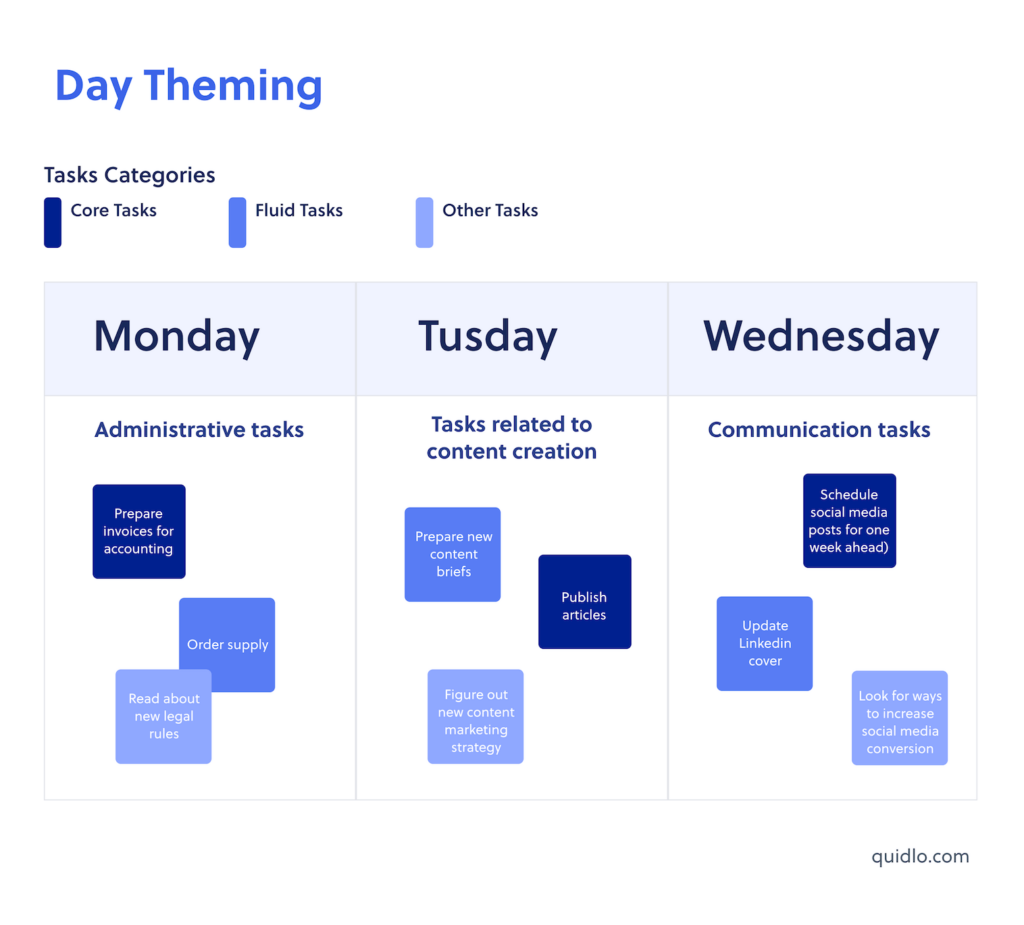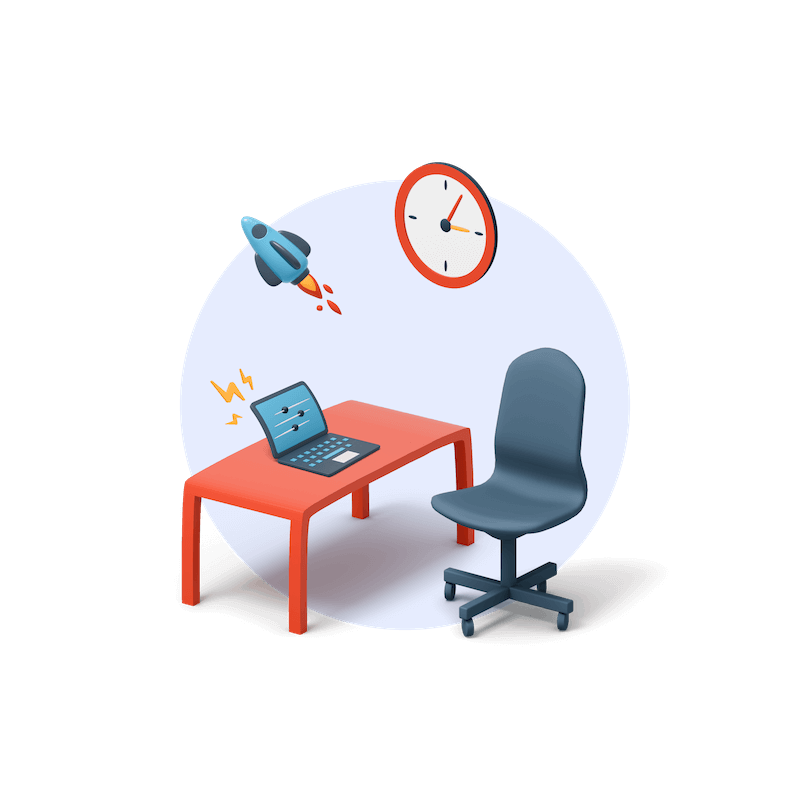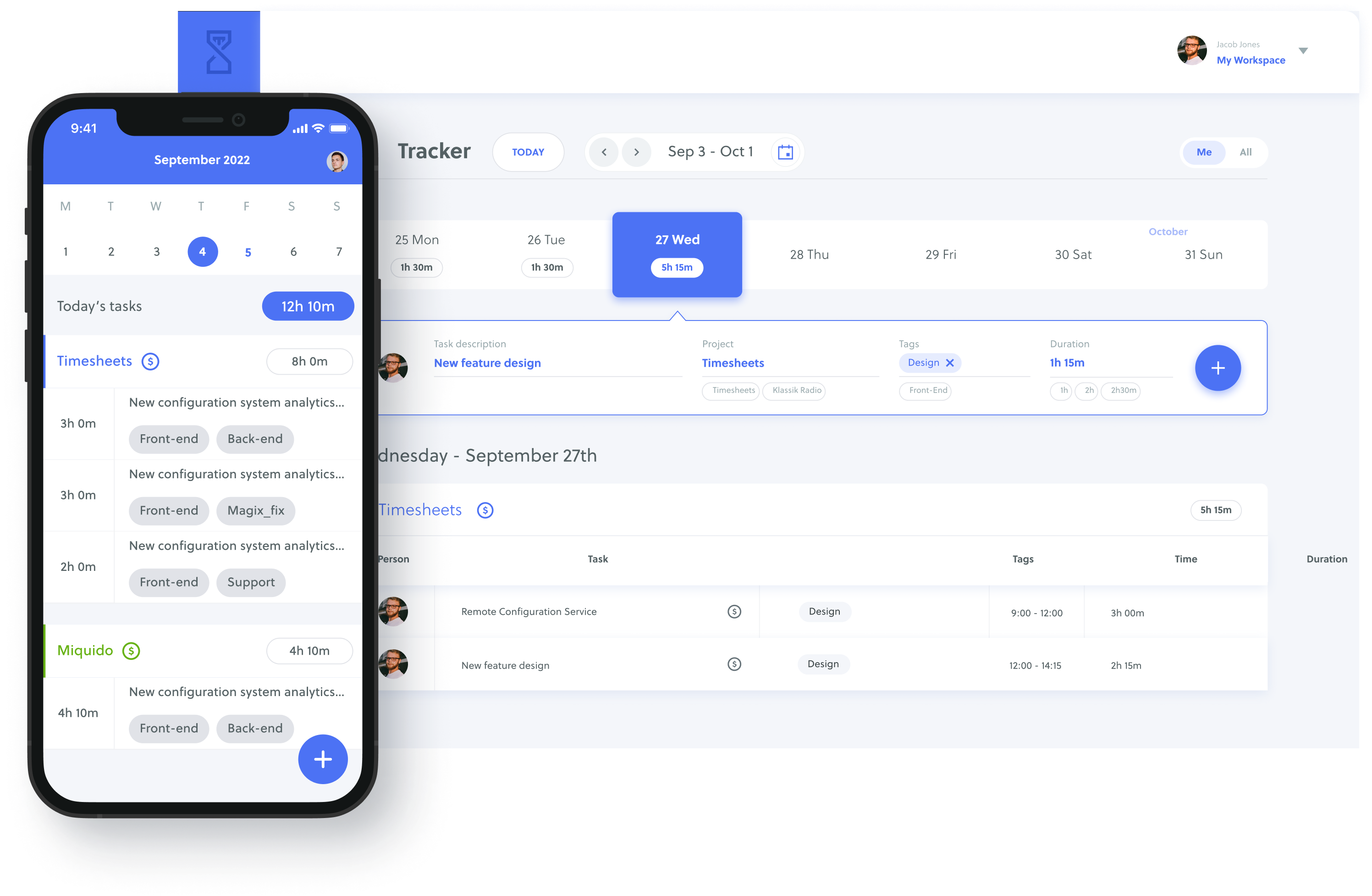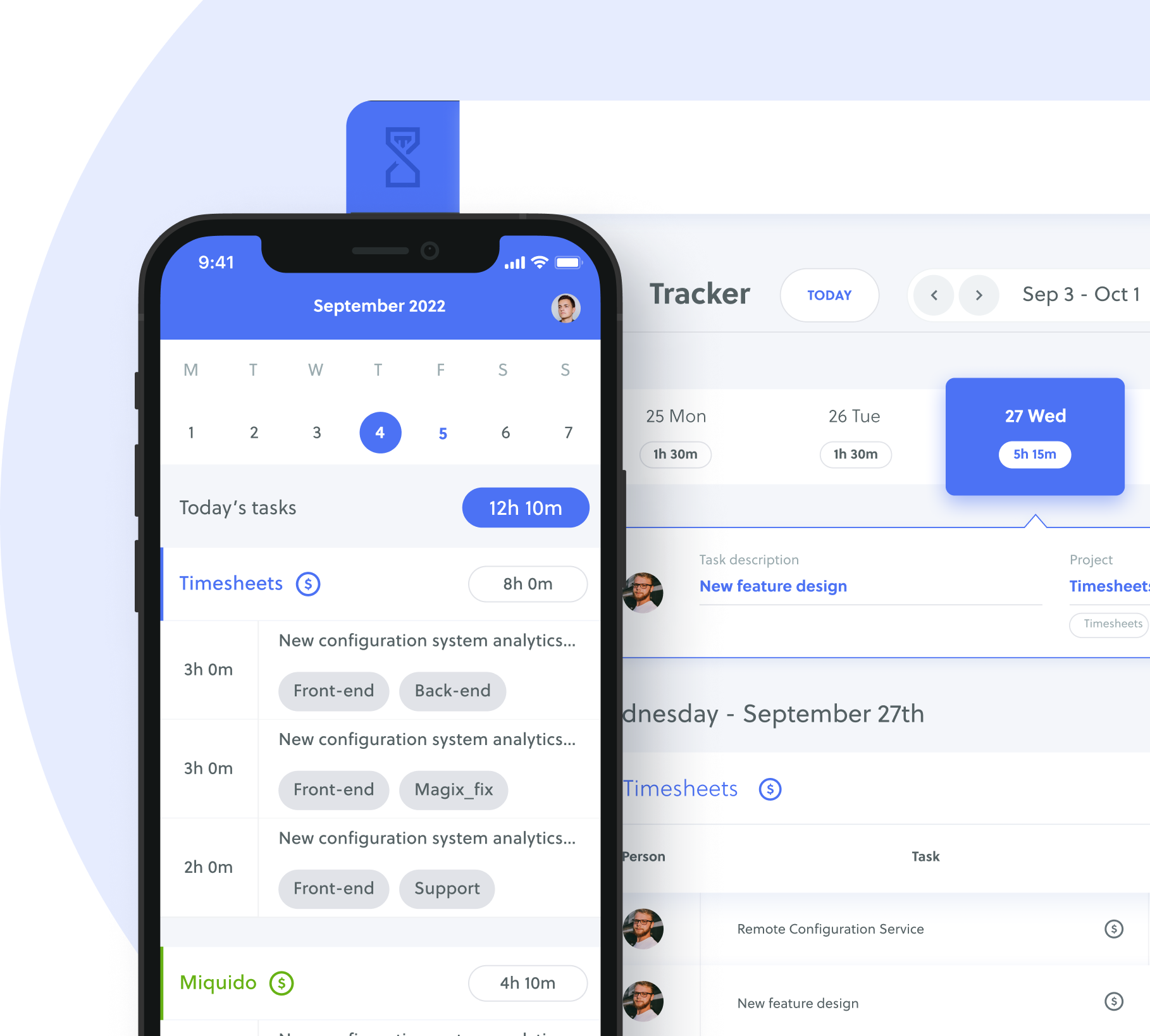Research suggests that multitasking can damage your brain and make you less productive. Moreover, an average employee can stay focused for only 2 hours and 53 minutes in a 9-hour workday.
For these reasons, we advocate for day theming, a productivity hack that can dramatically improve your focus both at work and in your personal life.
In this post, we’ll explore day theming in detail, along with its pros and cons.
Table of Contents
What Is Day Theming?
Day theming is a time management approach that involves task batching and creating themed days. You can group tasks of similar nature and have a day dedicated to each group.
For example, instead of having 30-minute meetings every day with different clients and team members, you can dedicate Monday to a specific theme of meetings.
This way, you’ll stay focused throughout the day and may find yourself striving to achieve the maximum output for each meeting. It will also prevent decision fatigue because you’re not constantly switching between very different tasks.
Interestingly, the University of California Irvine proved that it takes about 23 minutes and 15 seconds for people to start a task, get into the flow and stay focused on it. During this time, people usually deal with attention hopping, a state of mind where your focus is disturbed.
When attention hopping, you might find yourself thinking about your previous or upcoming engagements. As a result, you’ll have irrelevant tasks competing for your attention and will be unable to focus on the task at hand. Attention hopping is disruptive, and theming your days is one way to avoid it.
Remember that you can consider a weekly theme approach if you don’t want to allocate daily themes. The goal is to just excel at budgeting time and effectively work to solve complex problems.
👉 Read also: How to declutter your mind with the Monotasking time management technique.
How Can Day Theming Help Boost Productivity?
Day theming is an obvious productivity power tool. And you probably practice it in your daily life without even realizing it.
For example, recall when you told yourself you’d do the laundry and clean the house on Sunday. You’ve mentally dedicated the day to cleaning tasks, knowing it’s best to do them all in one day rather than distributing them over the week.
In other words, day theming is a productivity hack that most brains know by default. But despite being common sense, not many people use it.
That’s because a lot of people fail to realize its benefits. So here’s a list of day-theming benefits to help you understand the depth of its impact.
It Improves Prioritization
Have you ever planned to do something, and two years down the lane, you’re still planning? That’s probably because you’re unable to allocate time to it.
Scientifically, we tend to prioritize tasks with the nearest deadline. But when doing so, we ignore the value tied to each task. This means most people end up making bad deals with respect to priorities and spend a lot of time on things that aren’t necessary or could have been managed more efficiently.
For example, imagine your co-worker asks if you’re up for a quick 30-minute meeting to discuss an idea they just had. Your deadline to answer this question is nearer than the deadline for the email you were working on.
You’ll automatically choose to answer first (which may lead to a meeting you did not plan to have). As a result, you end up in a loop of tasks that distract you from your original goals.
Dedicating tasks to each day of the week helps with this by allowing you to prioritize and organize tasks by their nature and importance.
It Reduces Start-Up Time
As mentioned earlier, the brain takes around 25 minutes to get familiar with a new type of task (which is called context switching).
If you schedule five different tasks for the same day, you’ll need 25 minutes before each to focus on them fully. This means you will be wasting approximately two hours on task preparation.
On the contrary, if you batch similar tasks together and execute them on the same day, you won’t have trouble switching from one task to another because they’re all in the same context. Your mind is already thinking in that direction.
It Helps With Self-Discipline Issues
Self-discipline requires loads of patience.
It’s difficult to stay dedicated to something for a long time, which is why we tend to lose interest if things drag on for over a month or so.
Now imagine you decide to learn a new skill.
If you dedicate 30-60 minutes each day to learning this skill, you’ll have to follow this schedule for at least two weeks to develop some degree of command over it. Sometimes, it may even take a few months, depending on the skill.
But not everyone can stay strong-willed for that long. Your passion and ambition will die eventually. And you will often find yourself avoiding or rescheduling this learning time.
On the contrary, if you dedicate two full days to learning this new skill, you’ll achieve way more than you would by spending only an hour a day on the skill. Your learning will also be more focused and bring about better output.
What Is The Difference Between Day Theming And Time Blocking?
Unlike day theming, you might have already heard of time blocking. It’s been one of the most popular buzzwords since the pandemic.
Time blocking is also a time management technique where you create blocks of time (instead of different themes for each day) and dedicate them to specific tasks.
For example, if you have a 9-hour work day, you can divide it into three equal sections. Each section will have tasks of similar nature. Here is an example of how you can allocate your time:
9 am – 12 pm: Reply to emails and conduct internal meetings
12 pm – 3 pm: Create proposals and do client work
3 pm – 6 pm: Administrative work
But between these blocks, you’ll need to budget sufficient time for lunch and urgent tasks. This means time blocking keeps you focused for a specific number of hours but not the entire day.
So, is time blocking better than day theming? The answer is no. Day theming is basically an advanced version of time blocking, which is why it’s also better.
However, depending on your current focus level and routine, it may not be the best choice for you. That’s particularly true if your current routine involves heavy multitasking. So we recommend practicing time blocking first and then leveling up to day theming.
Is Day Theming A Deep Work Technique?
Deep work refers to distraction-free time to do focused work. During this time, you’re not interrupted by anything at all, meaning your focus continues to improve.
We’ve reviewed the concept of day theming above, and in light of that, day theming can serve as a deep work technique.
As you dedicate a day and continue to work on similar-natured tasks throughout it, your focus continues to improve. By mid-day, you will find yourself producing some of your best work.
How To Practice Day Theming?
Day theming is easy to implement if you take an organized approach.
First, determine if you practice time blocking (consciously or unconsciously) in your current routine. If you do, that’s great.
But if you don’t, start with time blocking first. Prepare a to-do list at the start of the day and divide your hours between similar-natured tasks. Make sure you give at least 1-3 hours to each group and practice this for a week or two before switching to day theming.

For day theming, plan your upcoming themed days at the end of each week. Each day should have a theme. For example:
Monday: Administrative tasks
Tuesday: Tasks related to content creation
Wednesday: Communication tasks
And so on. For each day and its corresponding theme, jot down your tasks in a to-do list. We recommend following this structure to divide your tasks:
Core Tasks: These are important tasks relevant to the maintenance and growth of the business/service you offer.
Fluid Tasks: These tasks have a changing nature. They may change every week.
Other Tasks: These optional or miscellaneous tasks may or may not demand space in your schedule. Generally, optional tasks are conceptual or creative, such as brainstorming.
This way, you won’t waste time figuring out which task is most important or what to do next. Planning the entire week can take 3-4 hours initially. But once you get into the flow, it’ll take one hour at most.
Tips To Improve Day Theming Results
The human brain tends to find ways out of a situation it doesn’t want to face. For a lot of people, work is one such situation.
So, even with this deep work time management technique called day theming, you might often find yourself distracted as your attention suffers.
So here are three ways to improve day theming results and organize your brain’s attention even better.
Get A Personal Workspace
To harness the true power of a themed day, you must have zero interruptions.
And one way to prevent distractions is to avoid working in shared rooms or at shared tables.
Instead, get yourself a personal space free from unwanted noise and chatter. A closed room with a dedicated desk and no interruptions will work if you work from home. But if you work in an office, you may need a separate, isolated desk in a quiet corner.
If your employer can afford you a room, it’s probably the best way to spend uninterrupted time on an important task.
Remove Distractions From Around You
Having a personal room doesn’t mean you should equip it with other distractions like a TV, PlayStation, or a pet. So make sure you keep all these distractions out of the room.
For your peace of mind and relaxation, you can have a window in the room, a few green indoor plants, and an aesthetic interior.
Distractions also include your smartphone and playlist, so keep them out of your reach and use app locks when working on a certain project.
If you need to communicate with your team via Slack or Mattermost, lock yourself out for 60-90 minutes and check up on your team after dedicated working hours. Otherwise, inevitable requests or an urgent query will take away your laser focus, forcing your brain to spend another 25 minutes before settling back.
Work In Short Bursts
Dedicated days do not mean pushing yourself beyond your limits. Breaks are necessary, so take ample 10-20 minute time-outs along the way.
It’s up to you how you schedule your breaks, but one 20-minute break every 60-90 minutes is good.
Themed Days Simplified
We hope that this article was helpful in introducing you to the concept of day theming. This technique can improve your focus, productivity, and overall results if implemented correctly.
But as with all other time management techniques, day theming requires dedication and consistency.
So set yourself up for success and give day theming a shot! You won’t regret it. Good luck!






